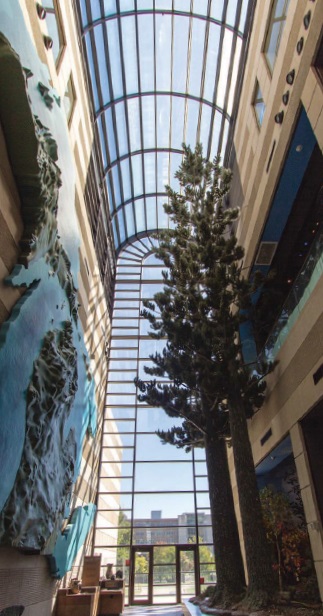Self-cleaning glass
R. David Whitby, Contributing Editor | TLT Worldwide March 2022
There are two different types, but both clean themselves through the action of water.

Slipperiness is a very useful feature in many applications, as all tribologists will know from their understanding of lubricants and lubrication. It also benefits some surprising situations, one of which is self-cleaning glass. Dust and dirt on a self-cleaning glass is easily removed every time it rains or the glass is washed.
Two types of self-cleaning glass have been developed: hydrophobic (water hating) and hydrophilic (water loving). Water droplets roll off a hydrophobic glass surface, while sheets of water slide off a hydrophilic glass. Both actions carry away any contaminants, whether organic or inorganic, which have adhered to the glass when it was dry.
Hydrophobic glass has a water repelling coating of a transparent film, which inhibits most dirt and other contaminants from bonding to the glass. Because a hydrophobic glass surface has a very high static water contact angle, when water droplets hit the surface, they combine together into larger beads and easily roll off the surface, picking up any dirt or dust. To be classed as hydrophobic, a surface must have a static water contact angle greater than 90 degrees. Self-cleaning hydrophobic glass also must have a very low roll-off angle. This is the minimum inclination angle required for droplets to roll off easily.
Several companies market coatings to make glass hydrophobic. Most appear to be proprietary. Some are applied to the windshields of cars and small boats used in freshwater lakes and rivers. Boats used in saltwater environments do not normally have hydrophobic glass coatings as salt water tends to dry on the glass, leaving small deposits of salt that must be wiped off, tending to damage the coating. The surface coating causes the water droplets to have less contact with the glass, become rounder and take up less surface area. This makes it easier for windshield wipers or wind to remove them, helping to minimize smearing and improving visibility.
Hydrophobic coatings also are applied to panes of glass used in architecture, such as glazed curtain walling, glass atriums and high-rise buildings. In addition to being self-cleaning, the protective coating also helps to make the glass scratch resistant. Another benefit is that makers of motion pictures are now able to shoot in all weather conditions, making many scenes more authentic. Older types of camera lenses were made of hydrophilic glass, so some wintry scenes could become blurred, or the lenses had to be cleaned regularly. Modern camera lenses are made of hydrophobic glass, so pouring rain or a humid climate does not affect the picture or visual quality.
Hydrophilic glass is based on an ultra-thin coating of titanium dioxide. Pilkington claims to be the first company to develop this type of self-cleaning glass in 2001. Its glass has a 20-30 ηm layer of nanocrystalline anatase titanium dioxide deposited by an atmospheric pressure chemical vapor deposition technique onto soda-lime silicate float glass. The glass has a visible reflectance of around 7% and a visible haze of less than 1%. It also absorbs 20% of incident solar ultraviolet (UV) light, which is used in the self-cleaning process.
In the first stage of the self-cleaning process, the coating reacts with UV light to photo-catalytically break down organic dirt. In the second stage, when water hits the glass, instead of forming droplets, it spreads out evenly, running off the surface in a sheet, taking the loosened dirt with it. The resulting cleaned surface also dries quickly without leaving streaks. The coating is claimed to be robust and is not damaged by the application of tape or moderate mechanical abrasion.
Several other companies have introduced hydrophilic self-cleaning glass using titanium dioxide coatings. Almost all of the applications appear to be with glass used in homes, such as windows and conservatories. This type of self-cleaning glass does not seem to be used in commercial buildings, such as offices and high-rise apartments. This might be because the methods of installing large panes of pre-treated glass in buildings damages the ultra-thin titanium dioxide coating.
Companies that supply hydrophilic glass contend that it stays cleaner for longer, and less dirt and dust adheres to the glass, so any cleaning is quick and easy. In addition, self-cleaning glass is more environmentally friendly, with a less frequent use of water and detergents. They also maintain that the coating will last the lifetime of a window frame. Another benefit is the clear view through the glass, even when it’s raining, due to the sheeting effect.
David Whitby is chief executive of Pathmaster Marketing Ltd. in Surrey, England. You can reach him at pathmaster.marketing@yahoo.co.uk.